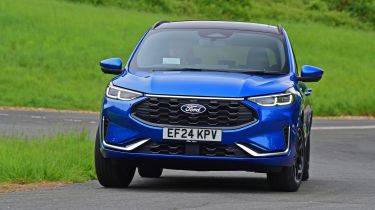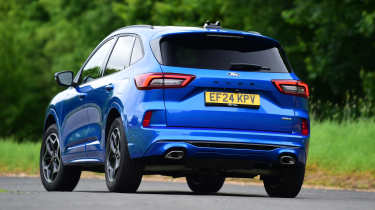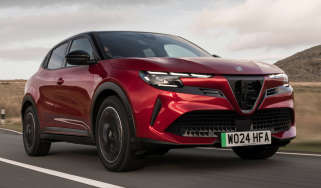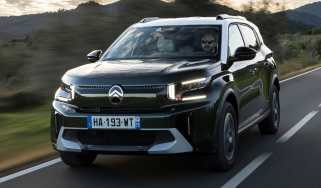Ford Kuga review - Engines, drive & performance
"The Kuga is one of the better family SUVs to drive – especially when paired with a manual gearbox"
It’s safe to say that previous Kugas have been a mixed bag to drive. The first-generation car was more fun than almost all of its rivals, but Ford tried to make the next one appeal to a wider audience, and it lost some of its sharpness as a result. We’re happy to report that the latest car is a return to form; it’s more agile than you might expect from a big family SUV and doesn’t lean too much if you take a corner quickly.
The downside of that is a slightly firm ride. You’ll notice the imperfections in the road more than you would in a Volkswagen Tiguan, but we didn’t find it uncomfortable and most bumps were absorbed without any fuss. The car can start to feel fidgety at higher speeds but that’s mainly noticeable on rougher surfaces. Picking the biggest wheels, like the ones on our test car, makes the issue a little worse, so we’d stick to the 17 and 18-inch alloys.
We found the steering light but it still has a lot more feel than plenty of other SUVs; this can be firmed up by placing the car into sport mode, while the manual gearbox, standard with the 1.5-litre petrol engine, is precise and great to use. On a twisty road, the Kuga can feel closer to a sporty family hatchback than a lumbering SUV, with brakes that are strong without being grabby.
Ford Kuga petrol engines
Two 1.5-litre EcoBoost petrol engines were carried over from the old Kuga, but the entry-level 118bhp engine has now been discontinued. The 148bhp version can get from 0-62mph in 9.7 seconds and has a top speed of 121mph. It's fitted with a six-speed manual gearbox and front-wheel drive as standard.
While this may seem underpowered for such a large car, Ford’s EcoBoost engine offers more pep than the numbers suggest and pairs well with the slick manual transmission. Thanks to the lack of any form of hybrid assistance, the petrol is the lightest model in the Kuga range too, meaning it should feel the most eager on an open B-road, despite lacking the extra power of the hybrids.
Hybrid engines
The Kuga is available as a self-charging hybrid (Ford labels it as FHEV) and as a plug-in hybrid (PHEV), which we've also tested separately. Both use a 2.5-litre petrol engine, an electric motor and a battery which provides all-wheel-drive. The FHEV uses engine power and kinetic energy to charge the battery, whereas the PHEV can be plugged in, either at home or at a public charger.
More reviews
Car trim reviews
In-depth reviews
- Ford Kuga review – a sharp-handling and efficient SUV
- Ford Kuga Plug-in Hybrid SUV review
- Ford Kuga SUV (2008-2012) review
Used car reviews
In both models, the Kuga will generally move off in near-silence thanks to the electric motor. Power is instant and delivered smoothly, and the hybrid’s small battery doesn’t ruin the Kuga’s impressive handling. The FHEV produces around 180bhp and reaches 0-62mph in a fraction over nine seconds, while the 240bhp plug-in hybrid cuts this to 7.3 seconds.
Both cars use a CVT gearbox, which is different from a normal automatic as there aren’t any individual gears; this is used to good effect on several hybrid SUVs such as the Toyota RAV4 to create a relaxing driving experience. However, it doesn’t suit the Kuga’s sporty nature and can be sluggish to respond, bringing the revs up too high when you accelerate hard, resulting in an unpleasant droning noise.
Diesel engines
Diesel engines were discontinued in the Ford Kuga in November 2021, following a decline in sales and Ford's decision to move away from the fuel. When offered, the 1.5-litre EcoBlue diesel engine was the only Kuga available with the choice of manual or automatic gearboxes. The entry-level version's 118bhp never felt like it had quite enough power in the Kuga, while the 148bhp 2.0-litre unit utilised mild-hybrid technology and felt like the sweet spot in the range. An even more powerful 187bhp 2.0-litre model was also offered and came as standard with an automatic gearbox and all-wheel-drive – although this was a chunk more expensive to buy and much less economical.












